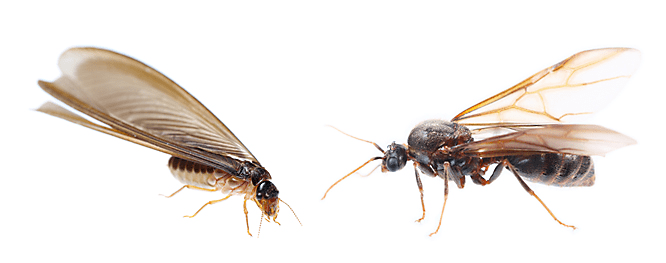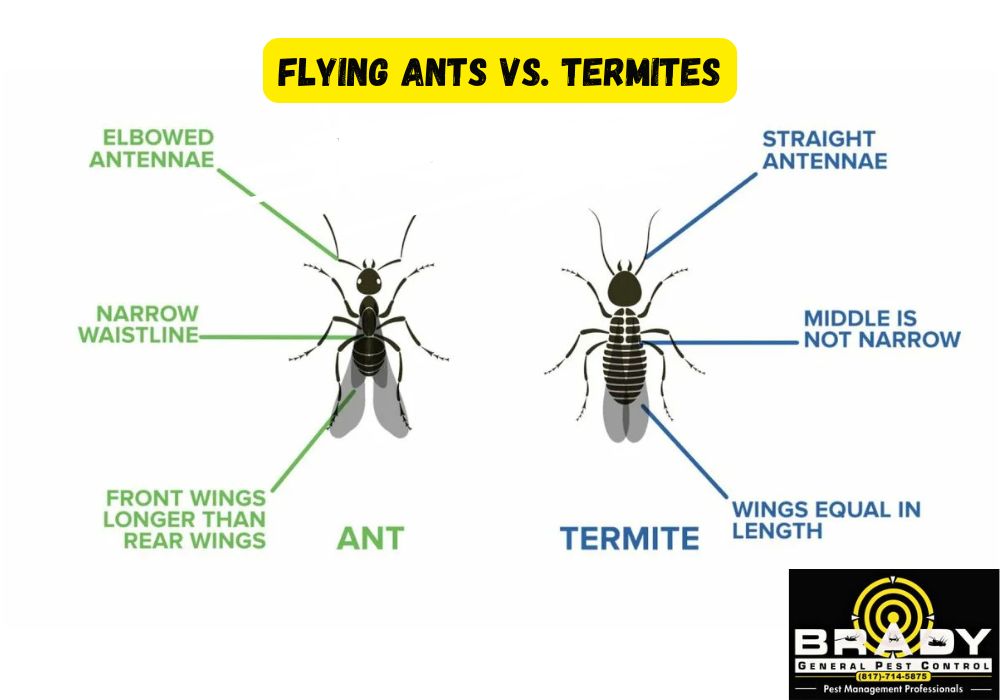Insects that swarm around the house are a cause of concern for homeowners. Are they flying ants or termites? Any of them can be bad news, but termites can directly harm the structure of a building when left untreated. Flying Ants vs. Termites—Let Brady Pest Control in Grand Prairie, TX, explain the importance of knowing them and how to deal with them.
How to Identify Flying Ants vs. Termites
Physical Differences

It makes it easier to know what to look for to identify the pest. The physical appearance of flying ants and flying termites distinguishes them.
Termites: Straight antennae, equal size of wings, and straight waist are some characteristics of the termites. Their white wings are situated right on top of each other. It makes them seem like a compact mass.
Flying Ants: Carpenter ants are categorized as flying ants and have peculiar features. They have antennae that are bent or elbowed, wings but not of equal size, and a constriction in the middle of their body. Their wings are usually yellowish or brownish and are slightly see-through.
Are you struggling to differentiate between flying ants and termites? Contact Brady Pest Control in Grand Prairie, Texas!
Behavior and Habitat
Knowing the character of every pest can provide more hints as to its identity and how to manage it.
Termite Behavior: The termites build their nest in the wood and feed in it. It causes lots of damage to the structures. They are very drawn to areas that have moisture.
Ant Behavior: Unlike termites, carpenter ants also create tunnels for nest purposes. They are less destructive to structures. These are signs of moisture problems because the insects favor areas with humidity.
Differences in Diet
These insects cause different types of damage depending on their diet.
Termites: Termites are extractive feeders that feed on cellulose and hemicellulose found in wood, paper, and other plant-fibrous materials. They damage wooden structures.
Ants: Ants feed on plants and animals, though mainly taking nectar, seeds, other insects, or crumbs of food. It may feed on food inside houses. They do not eat wood like termites do.
Why You Should Not Waste Much Time?
Every year termites inflict billions of dollars of property damages. In states where homeowners spend lots of money on repair, their insurance does not cover this repair expense. Flying ants are less destructive.
Don’t wait for it to get out of hand. Call Brady Pest Control to book your termite inspection today!
How to Identify a Flying Ant or Termite Swarm?
In pest infestation, you should act on it as soon as you notice it. A professional inspection is useful as it establishes the type of pest and the most appropriate action to take. Brady Pest Control recommends homeowners seek professional pest control for effective long-term solutions and to free their minds from constant worrying.
Final Words!
If you are still in doubt about whether you are dealing with flying ants or termites, do not jeopardize your home safety. Brady Pest Control in Grand Prairie, Texas, provides reliable pest services for identification and treatment. Please contact us at 817-714-5875. Fill out the form today.
FAQ
How do I know if I have termites or flying ants?
Termites have thick straight waists while flying ants have pinched waists.
Why do I suddenly have flying ants?
It may be a mating season, so ants are swarming to find new colonies.
Are flying ants harmful?
No, flying Ants aren’t harmful to humans.
How to get rid of flying ants or termites?
Wherever they fall, use Diatomaceous earth or spray insecticide.
How do I get rid of flying termites permanently?
Termite control treatments include the use of termite baits, chemical nematodes, diatomaceous earth, cardboard traps, and cedar mulch as long-term control measures.


